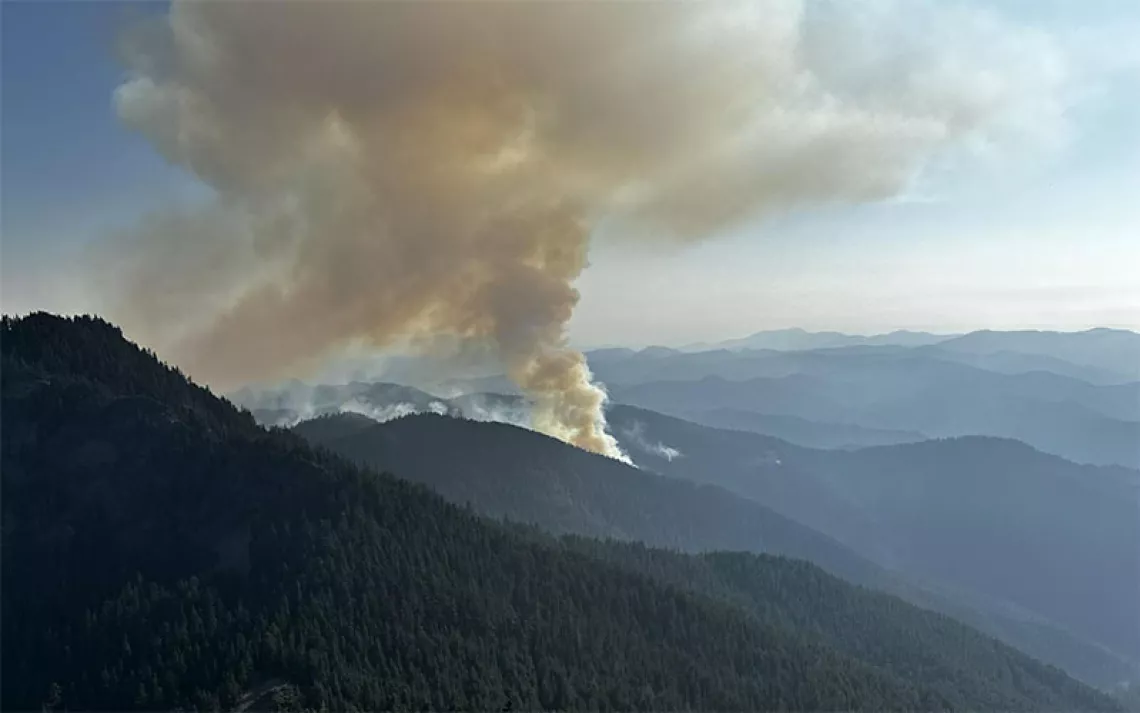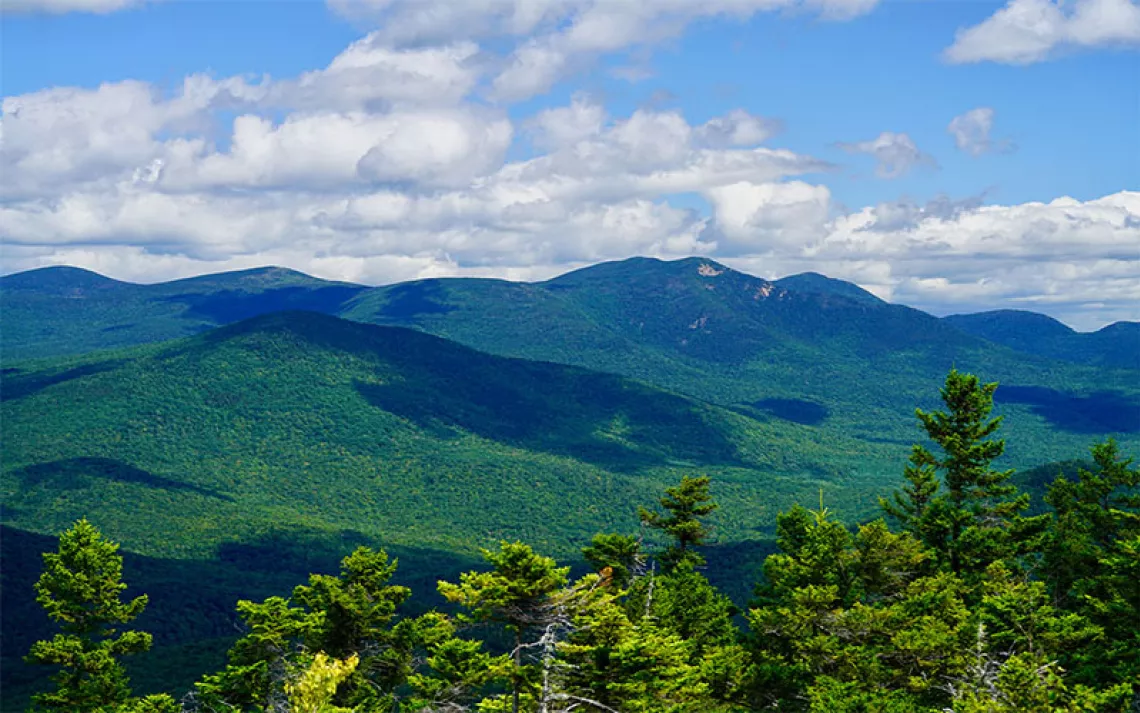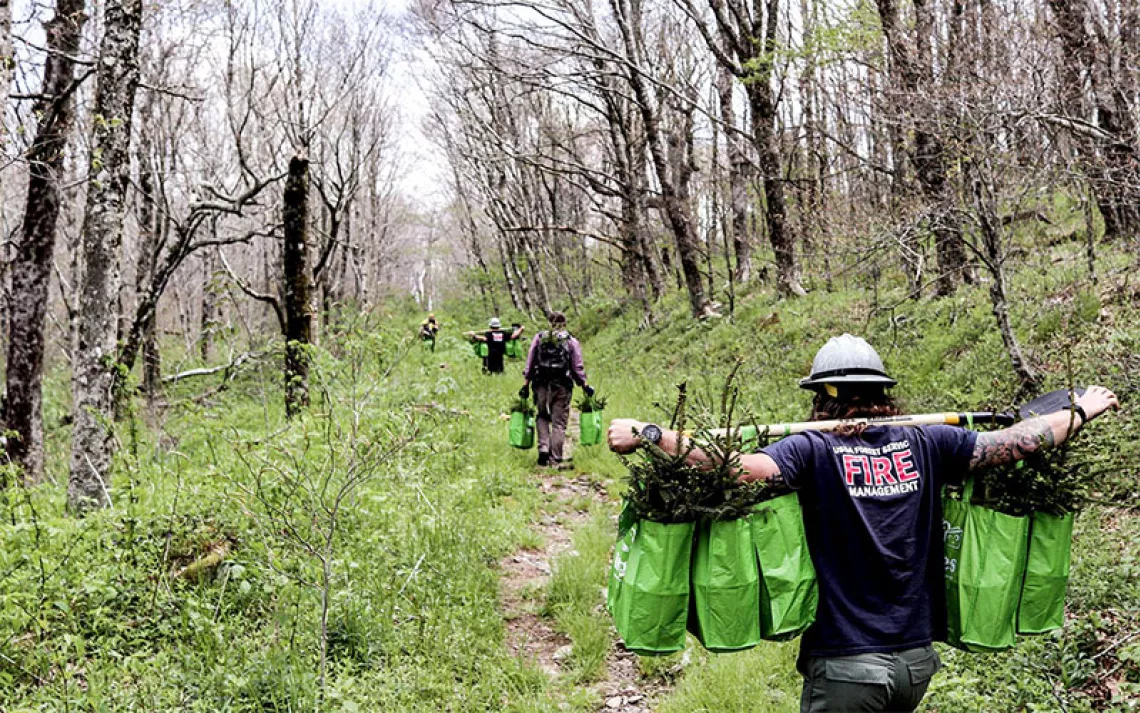The Mystery of the Missing Ferns
Strange happenings at Seward Park turn neighbors into fern detectives
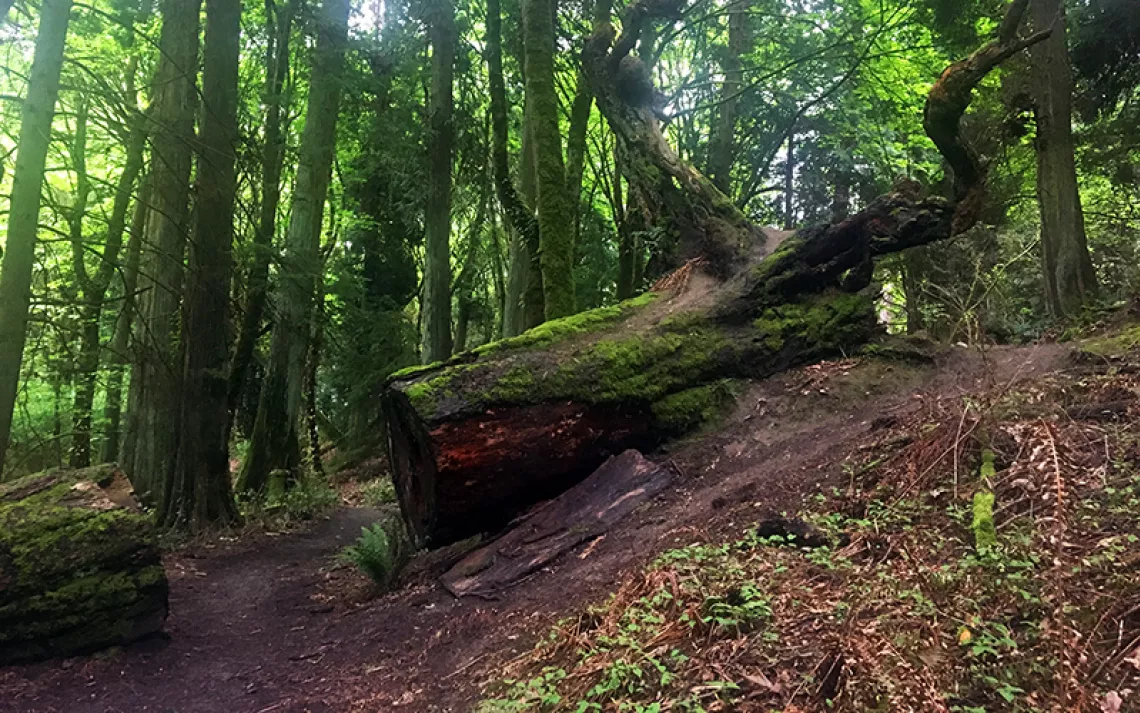
Seward Park in 2017, after the ferns disappeared. | Photo courtesy of Paul Shannon
Four years ago, Catherine Alexander was sitting in one of her favorite spots in Seattle’s Seward Park when a new observation rose to her consciousness: Something was wrong with the sword ferns.
At first, she couldn’t figure out what had changed. But over the course of a week, she worked out the pattern. The ferns’ shape was different. They sagged, as if they’d been flattened by a heavy snow.
“At first I couldn’t get anybody to take me seriously,” Alexander recalls. She mentioned her observations to park maintenance workers and a crew conducting a plant census, but they gave her the brush-off. Then she told Paul Shannon, a neighborhood friend who had been been volunteering on maintenance and restoration projects in Seward Park for a decade.
Shannon had lived in Charlottesville, Virginia, during a period when invasive species and pathogens radically reshaped the landscape of the Blue Ridge Mountains. He had seen doomed shoots sprouting from the stumps of trees felled decades earlier by chestnut blight, and hemlock trees gradually invaded by the woolly adelgid, an invasive insect from East Asia. She also pointed out the ferns to another regular Seward hiker, an ecologist and a lecturer at the University of Washington named Tim Billo, who had studied the chestnut blight as an undergraduate.
The trio kept tabs on the ferns with a mixture of interest and concern. Billo, in particular, thought Alexander had made an interesting observation, but wasn’t sure if it was a symptom of anything bad. Their worries increased the next spring, when the ferns failed to make new fiddleheads. Then the old fronds began to turn brown and die, until dead ferns covered about a quarter of an acre.
Sword ferns (Polystichum munitum) make up the majority of the understory of the lowland conifer forests that once blanketed the region. The area where the ferns had died is part of the last remnant of this ecosystem in Seattle. It was never logged and is home to trees as many as 500 years old. Without the ferns, the forest looked radically different. What was once a slope covered with lush, waist- or chest-high ferns was now bare, brown soil.
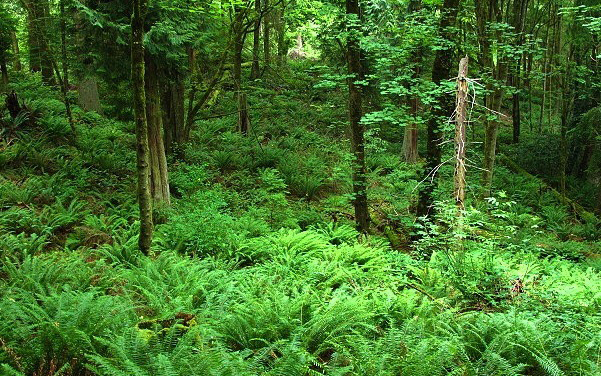
Seward Park before the fern die-off. | Photo courtesy of Jordan Jackson
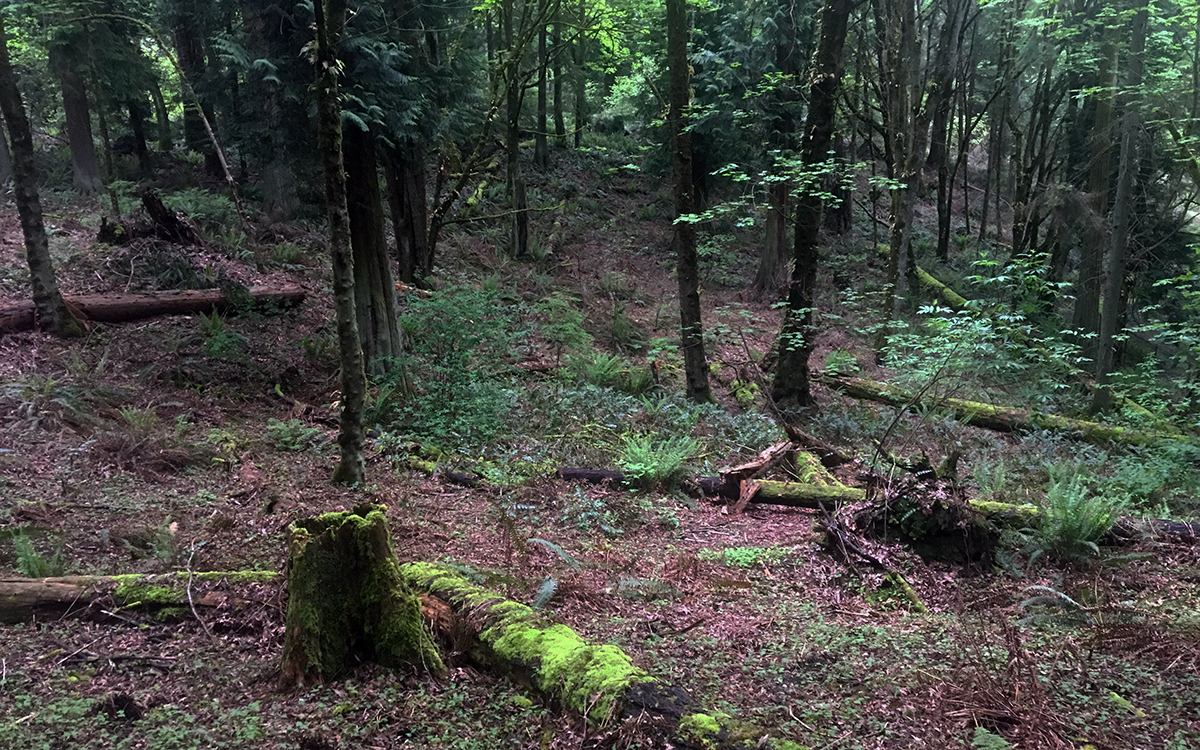
The same area after the ferns disappeared. | Photo courtesy of Paul Shannon
Billo, Shannon, and other park regulars formed an ad-hoc working group of professional and citizen scientists to search for the cause. They considered and discarded numerous hypotheses: drought (the region’s rain data didn’t match up), hungry mountain beavers (those tend to clip fronds off at the base, not causing intact fronds to shrivel and die).
Marianne Elliott, a plant pathologist at Washington State University, collected soil and root samples from unaffected and affected ferns. Her suspect: Phytophthora, a group of soil-dwelling, funguslike microorganisms that includes many species harmful to plants. But analysis of the samples back in the lab revealed no more Phytophthora on affected ferns compared to unaffected ones.
In the fall of 2015, Billo and some of his students established 20 three-meter-by-three-meter monitoring plots in and around the affected area of the park and mapped the perimeter of the area where the ferns were dying.
“We were sort of hoping it might correct itself,” Billo recalls. Maybe the dying ferns were simply reaching the end of their life-span. Maybe it was normal for them to suffer a temporary or even multiyear die-back due to drought or insect outbreaks. “We were also sort of wondering, second-guessing ourselves—is this thing getting worse or not?” he says.
That year, 3 percent of the ferns in the plots were completely dead. When they resurveyed the plots in fall 2016, over a third of the ferns had succumbed. The area where ferns were dying had expanded beyond the previous perimeter, doubling in size.
AS OF THIS SUMMER, 11 acres of sword ferns have died in Seward Park. Mysteriously, nothing is growing back on the bare ground left behind—not even weeds. “That’s another thing that points to the fact that there’s something weird going on here,” says Patti Bakker, who directs restoration programs with the Seattle Parks Department.
Because no cause has been identified, it’s difficult to be sure that the disappearing ferns represent a distinct phenomenon—a systematic die-off rather than just a patch of dead ferns. “Still,” says David Barrington, a professor of plant biology at the University of Vermont, "there’s no record of anything like this in the sword ferns.” The species has an extensive range in western North America and is known for its hardiness.
And Seward Park isn’t the only place where sword ferns are dying. “We’re starting to see things that look pretty darn similar in a bunch of places,” Billo says.
The working group has strict criteria that other sites have to meet in order to be classified as part of the Seward Park mystery. A die-off has to cover at least 400 square feet, affect an area where the understory had previously been dominated by sword ferns, and spread in a similar pattern as at Seward Park.
Even so, the group has identified half a dozen likely or probable matches to what was happening in the park around the Puget Sound region, including one site in a park in the Seattle suburb of Mercer Island and another in the foothills of the Cascade Mountains.
The strongest match is a spot on the Kitsap Peninsula, directly across the Puget Sound from Seattle. Heidi Danilchik’s family has owned the property since the early 1950s.
Danlchik noticed the problem there in early 2010. She realized the ferns looked different—“flat” rather than “fluffy” is how she puts it. For a while, the observation remained at the edge of her awareness. She was busy taking care of her dying mother, who was in an assisted-living facility in Seattle. A month after her mother passed away, Danilchik left the country for a year.
When she returned in late 2011, she turned into the driveway and saw what she describes as “brown dead ferns as far as the eye can see.” The blight spread out for at least an acre and a half, she estimates.
She ordered soil tests, but the results found no poison or chemical that could be pinpointed as a cause. The affected area continues to expand, and, as in Seward, nothing is growing back to replace the ferns. Earlier this year, she came across the blog Paul Shannon keeps about the die-off mystery in Seward Park and was relieved to find that her own mystery wasn’t unique.
The loss of sword ferns could permanently change the ecology of affected sites. That’s because the ferns tend to establish in open areas after a fire and don’t reproduce sexually under closed-canopy forest. The ferns that have died at Seward Park are likely to be as old as the trees around them—hundreds of years.
Elliott and others believe that some yet-unidentified pathogen must be involved, because the die-off is symmetrical and grows exponentially in an outward-radiating fashion. “It certainly looks like a soil-borne pathogen or biological agent of some type,” says Elliott. If the die-off continues at its current rate, all the ferns in Seward Park could be gone in 10 years.
WE ARE LIVING IN AN ERA of disappearance. In July, researchers published an analysis in the journal Proceedings of the National Academy of Sciences showing that the current worldwide loss of biodiversity is not just a matter of species extinctions but declining populations as well.
And in fact, the sword fern story echoes those of other recent die-offs affecting disparate taxonomic groups—frogs, bats, bees, sea stars. It may offer a glimpse into how these events begin and how people make sense of these uncertain first stages.
The absence of the ferns is now so dramatic that no one can miss it. But if it hadn’t been for Alexander’s observations, “We’d be another two years behind on the monitoring and the solution to the problem,” Billo says. In an age of die-offs, a key skill for a naturalist is being able to recognize not only the kinds of living things but also the unusual patterns of their deaths.
This fall, the Seattle Parks Department plans to hire a consultant to coordinate monitoring efforts, determine the next steps in looking for a cause of the die-off, and develop plans for replanting.
Shannon has already begun to test the possibility of restoration in an informal way. Three years ago, he planted two sword ferns near the spot where the die-off began; one has survived. This summer he put in an Oregon grape and an Indian plum, two other native understory plants.
He points out a hemlock tree nearby with a curved base that gives it the elegant appearance of a ship’s prow. Above the bare, dry ground, the branches of a hazelnut shrub interlace with a vine maple.
“One forgets, and the baseline shifts. You say, Well, it’s still kind of a pretty place,” Shannon says. “But it’s dead. Or it’s dead for that one species."
 The Magazine of The Sierra Club
The Magazine of The Sierra Club

